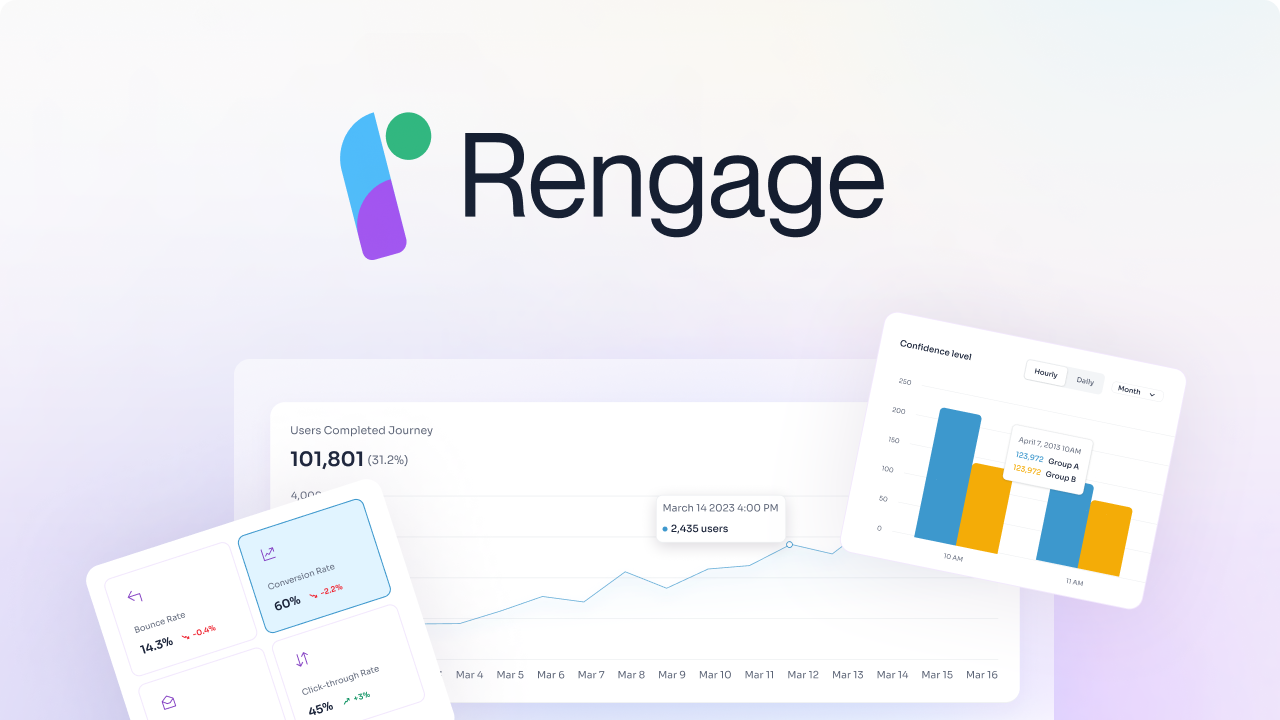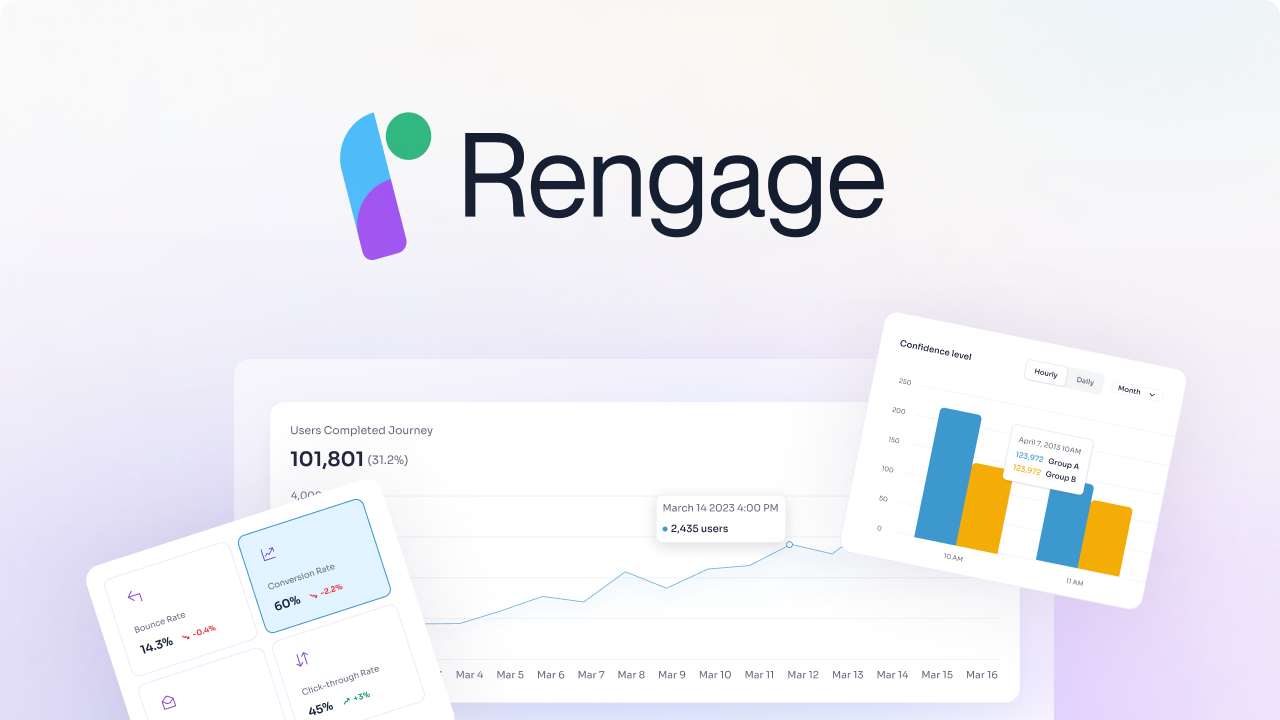25 Powerful Customer Data Platform Options to Unify Marketing
Are you struggling better to understand your customer base for effective marketing strategies? Get into Customer Segmentation Analysis within the marketing data platform landscape. This deep dive into segmentation and customer journeys will help you unlock the mysteries surrounding customer behavior to create personalized experiences that enhance loyalty and drive growth. Learn how to leverage these insights to refine your marketing efforts for optimal results.
We've designed Rengage to help you achieve your customer segmentation analysis goals effectively to drive loyalty and growth.
What Is a Marketing Data Platform?

Think about the last time you purchased a computer online. Your research process was probably something like this:
- Google searched, “The best computers of the year”
- Visited a number of computer review websites
- Visited a few retailers that sell computers
- Watched a few videos to learn more about the technical details of different computers
When you finally decided on what type of computer to buy, you probably researched the best place to buy it from. You visited a few additional websites to compare costs, shipping times, and return policies.
Throughout all of that, chances are you interacted multiple times with the company that you ultimately purchased from — through website visits, live chat, Facebook ads, and email.
The Role of CDPs in Personalized Customer Experiences
You might’ve noticed that each interaction with that company resulted in a more personalized experience. The ads you saw on Facebook felt extremely relevant to you, the website may have made subtle changes to seem more personal to what you were looking for, and their email follow-up, even though it was automated, felt like it was crafted for you. How was the company doing all of this? They were likely using a Customer Data Platform (CDP) to tailor their marketing to you.
Customer Data Platforms (CDPs)
A Customer Data Platform (CDP) is software that combines data from multiple tools to create a single centralized customer database containing data on all touch points and interactions with your product or service. That database can then be segmented in a nearly endless ways to create more personalized marketing campaigns.
CDPs Consolidate Customer Data
The best way to explain this is by example. Say a company is trying to get a better understanding of their customers. Their CDP would collect data from touch points like Facebook, the company’s website, email, and any other place a customer might interact with the company. The CDP will collect all of those data points, consolidate them into an easily understandable unified customer profile, and then make that profile usable to other systems that might need it — like the Facebook ads platform.
Leveraging CDPs for Audience Segmentation and Targeted Marketing
That process allows the company to use segmentation to better understand its audience and create more personalized marketing campaigns. For example, the company could easily create an advertising audience based on everyone who has visited a specific page on its website and also its live chat feature. Or, it could quickly segment and view data on site visitors who’ve abandoned their carts.
Related Reading
- Customer Data Infrastructure
- Omnichannel Analytics
- Customer Data Integration
- Predicting Customer Behavior
- Customer Data Platform Vs Data Management Platform
- Customer Data Platform Use Cases
- Best Customer Data Platform
- Customer Data Platform Capabilities
- Customer Data Platform Tools
- How To Choose Cdp
3 Key Components of a Marketing Data Platform

1. Packaged Software
A CDP is a prebuilt system, configured to meet the needs of each client. It requires some technical resources to set up and maintain the CDP, but it is less technical than a typical data warehouse project. This reduces the time, cost, and risk and gives business users more control over the system.
2. Persistent, Unified Customer Database
A CDP collects customer data from multiple sources, creating a unified, complete view of each customer. It pools and tracks customer data, such as behavioral data and demographics, to create a 360-degree view of each customer.
3. Accessible to Other Systems
A CDP has the ability to share data with other platforms, enhancing customer management and creating highly targeted, personalized marketing campaigns.
Enhancing Customer Journeys with Rengage
We provide a comprehensive solution for managing and enhancing customer journeys, delivering insights and measurable outcomes with no code. We accelerate your customer journey from onboarding, activation to conversion and churn. Enabling customers to unlock revenue from their existing user.
With Rengage, you can get insights into your segments, run campaigns with an intuitive journey manager, and get insights to measure how your journeys impact users conversion through our Journey Moments and Journey Builder features.
- Journey Moments: insights into your micro-segments
- Journey Builder: intuitive multi-channel marketing automation
- Insights prediction and attribution.
Book a free demo to learn about how you can transform customer interactions into personalized experiences that drive loyalty and growth.
Top 9 Benefits of a Customer Data Platform
 CDPs don’t just collect and store data. They process it into customer profiles that can be used to create single customer views (SCVs). Also called 360-customer views, SCVs are profiles created by a CDP from all the data gathered on a single customer. They provide marketers with a unified view of insights like their behaviors, information, purchase history, and interests.
CDPs don’t just collect and store data. They process it into customer profiles that can be used to create single customer views (SCVs). Also called 360-customer views, SCVs are profiles created by a CDP from all the data gathered on a single customer. They provide marketers with a unified view of insights like their behaviors, information, purchase history, and interests.
For example, each time a customer engages with a brand — whether it’s logging into a mobile app, reading a blog post, searching for a product, adding that product to a cart, leaving it in the cart, or buying a different product later — it’s all filtered into a SCV that acts as a summary of every way that customer has interacted with that brand. This clear and unified view allows marketers to better understand their customers and deliver more personalized experiences.
How Does a Customer Data Platform Work?
 I believe the CDP system is a powerful tool for collecting data, tracking customer behaviors, and storing valuable information. This data can be collected from various sources—CRM platforms, marketing systems, and data streams. The goal is to make all customer data available in a single place.
I believe the CDP system is a powerful tool for collecting data, tracking customer behaviors, and storing valuable information. This data can be collected from various sources—CRM platforms, marketing systems, and data streams. The goal is to make all customer data available in a single place.
As a hub, the specialized system will identify each customer by collecting data from different sources and will be able to stitch together data to create a unified customer profile. This is a process called "customer resolution."
Harmonize Your Data
In this process, the CDP will harmonize the data collected by stitching together different data sources to build unified customer profiles. It means linking different data sources together to create the customer identity. The process known as cross-device identity resolution allows companies to understand the full picture of their customers' journeys.
It allows companies to understand how customers interact with their brand, and these insights can be used to create a customized journey. This is a beneficial process for companies that want to build a personalized journey for their customers.
Experience Your Data
Data activation is the next step with the unified customer profiles created by the CDP. This process makes the data available for teams to personalize and create real-time customer experiences. Data activation is made possible by connecting the customer data in CDP to different platforms used by companies to engage with customers.
These platforms may include email send engines, automated workflows, real-time analytics, demand-side platforms, and content management systems. This is an essential process to create and maintain personalized customer experiences in real time.
Pull Insights from Data
The CDP platform is a great tool for gathering insights and pulling data from customer profiles. The unified customer profiles created by CDP allow companies to see the entire catalog of data each customer shared and track their entire customer journey.
These insights can be used to segment customers into groups, create lookalike audiences, and create personas to help reach out to new audiences. The CDP is a great source of information proving the efforts' reach, revenue, and marketing ROI.
Related Reading
- Customer Retention Automation
- Customer Data Integration Best Practices
- Real Time Customer Segmentation
- Chat CDP
- Customer Data Platform Implementation
- Benefits Of A Customer Data Platform
- Customer Segmentation Solutions
- Omnichannel Measurement
- AI Customer Segmentation
- AI CDP
- Customer Data Platform GDPR
- Customer Data Platform Costs
- CDP Personalization
25 Best Customer Data Platform Options for 2024
1. Rengage
 Rengage is a comprehensive solution that accelerates customer journeys from onboarding to conversion, enhancing insights and outcomes with no code. Features include intuitive journey management through Journey Moments and Journey Builder, insights prediction, and attribution.
Rengage is a comprehensive solution that accelerates customer journeys from onboarding to conversion, enhancing insights and outcomes with no code. Features include intuitive journey management through Journey Moments and Journey Builder, insights prediction, and attribution.
2. Insider
Insider offers easy customer data activation across websites, mobile apps, and messaging channels. It brings together all customer data for seamless activation.
3. Bloomreach
Bloomreach’s eCommerce personalization platform, including a CDP named Customer Data Engine, collects customer data from various sources. Its platform supports activation channels like email, SMS, and on-site, with automation and content management features.
4. Salesforce Marketing Cloud
Salesforce Marketing Cloud includes a CDP to aggregate data, better understand customers, and optimize marketing campaigns. Activation channels supported are email, SMS, on-site, and mobile apps, with tools for personalization, content management, and journey orchestration.
5. Emarsys
Emarsys features an Integrated Data Layer CDP that combines, cleanses, and analyzes data for a single customer view. It uses AI-powered audience segmentation to surface customer insights and supports activation channels like email, on-site, SMS, and mobile apps.
6. Segment
Segment, a standalone CDP by Twilio, integrates with popular marketing tools, customer support platforms, and data warehouses. It supports many activation channels and can be integrated with Twilio Engage for SMS and email campaigns.
7. Tealium
Tealium's CDP combines five products for unified customer profiles, data management, tag management, data collection, and machine learning-based behavior predictions.
8. mParticle
mParticle helps create a single customer view and segments and offers predictive analytics. Schema management tools help maintain data quality and support integrations with multiple tools for product, development, and marketing teams.
9. Treasure Data
Treasure Data unifies data and ensures compliance and security, supporting marketing, sales, and customer success teams. It offers data hygiene and advanced analytics use cases but lacks built-in activation channels.
10. Whatagraph
Whatagraph is a marketing data platform connecting, visualizing, and sharing data from over 40 sources. It helps consolidate customer insights from various data points and move data to Google BigQuery for advanced analytics and deeper insights.
11. Adverity
Adverity empowers marketers with an integrated data platform for connecting, managing, and using data at different scales. It blends disparate data sources to create business intelligence.
12. Klaviyo
Klaviyo focuses on email and SMS solutions for businesses, offering easy-to-use email marketing and automation services.
13. Ortto
Ortto helps collect unified customer data, offering segmented insights into the buyer's journey through automated email responses, personalized email builders, and templates.
14. Totango
Totango offers customer marketing platforms for small and large businesses, supporting customer success technologies. Big-name clients like Zoom, Google, and SAP use it.
15. Autopilot
Autopilot provides a global marketing platform with a CDP for unified customer data and powerful data segmentation. Its automated email response feature, drag-and-drop email builder, and templates are highlighted.
16. Blueshift
Blueshift is an AI-based marketing platform for engaging customers throughout the B2C lifecycle. App Hub facilitates tech stack connections and third-party platform integrations for easy use.
17. Listrak
Listrak offers cross-channel marketing with a strong email builder, behavioral triggers, customer insights, text message marketing, and predictive analytics using machine learning and statistical modeling.
18. SALESmanago
SALESmanago combines customer data and experience to provide seamless marketing solutions, helping top clients achieve significant results.
19. Microsoft Dynamics 365 Customer Insights
Microsoft provides personalized alerts, customer interactions, and automation using API through its Customer Insights platform, with a simple interface for easy navigation.
20. Actito
Actito streamlines marketing efforts for mid-sized to large businesses, offering tailored buyer experiences and customer satisfaction.
21. Funnel
Funnel encourages data-driven marketing with clean and accurate data collection, advertising support, analytics, and CRM features.
22. SAP Marketing Cloud
SAP Marketing Cloud offers a 360-degree view of customer information, real-time data feeds, a convenient interface, email deliverability, and strong analytics tools.
23. Lytics
Lytics leverages data using science and machine learning, providing audience segmentation, behavioral scoring, identity resolution, content affinity, journey orchestration, and personalization tools.
24. BlueVenn by Upland Software
BlueVenn, now under Upland Software, offers robust tools for unifying customer data, drag-and-drop analytics, excellent segmentation, and integration options for accurate customer profiles.
25. Optimove
Optimove caters to marketing and CRM professionals in data-focused environments, having served over 500 brands with $75 million funding and expansions across three locations.
How To Choose the Best Customer Data Platform

Determining Your Budget
When evaluating a Customer Data Platform (CDP), determining your budget is one of the first crucial steps. Many CDPs do not openly display their pricing, so you must request a custom quote to understand the costs involved. Be sure to prioritize the features and tools you require and inquire about any add-ons that may come at an additional cost.
Tools and Integrations Needed
Different CDPs offer integration possibilities with various tools and platforms. As a result, some platforms your company uses to store customer data may not be compatible with all CDPs. Make a list of the essential platforms, data sources, and tools that must be integrated with your CDP and confirm with the provider that your integration needs will be met.
Mapping Out Business Goals
Certain CDPs will analyze your company's use cases to establish your business objectives with customer data. They will ensure that the software they offer can meet these goals. To prepare for this, gather your key stakeholders and compile a list of their goals. Prioritize these goals from critical to nice-to-have, and consider best data protection practices.
Formalizing Your Selection
Once you have narrowed your options to a few CDP providers that align with your business needs, it's time to formalize your selection. Use customer reviews to help you identify the most suitable provider. To confirm your decision, reach out and schedule a meeting to open a dialogue between your selected CDP provider and key stakeholders.
Essential CDP Features
When selecting a CDP, consider essential features such as data integration, data cleansing and unification, segmentation and personalization, real-time data processing, analytics and reporting, multichannel support, and security and compliance. These features are crucial for creating a customer-centric marketing strategy.
Integrations
A well-designed CDP should seamlessly integrate with your current tech stack. When deciding on a CDP, consider prebuilt integrations, integration capabilities, in-house integration experts, ecosystem-neutral CDPs, and the quality of product documentation. Ensure that the platform can connect with any part of your tech stack and support custom integrations.
Other Important Considerations
It is important to recognize that a CDP requires a long-term commitment once integrated into your digital ecosystem. Ensure stakeholders understand what they are committing to and how to derive value from the platform. Evaluate vendor stability, flexibility, and support when choosing a CDP to drive growth and success for your business.
Create Personalized Experiences That Drive Loyalty and Growth with Rengage — Book A Free Demo Today
Rengage offers a marketing data platform that provides a comprehensive solution for managing and enhancing customer journeys. It delivers insights and measurable outcomes without the need for coding. With Rengage, we accelerate your customer journey from onboarding and activation to conversion and churn, enabling you to unlock revenue from existing users.
Insights into Segments
Gain valuable insights into your customer segments with Rengage. Our platform helps you better understand your audience, enabling you to tailor your marketing strategies to meet their specific needs.
Intuitive Journey Manager
Run campaigns seamlessly with our journey manager feature. Create personalized customer journeys that drive engagement and conversions across various channels without the need for complex coding.
Journey Moments and Journey Builder
Journey Moments provides insights into your micro-segments, helping you understand how different types of users interact with your brand. The Journey Builder feature offers an intuitive multi-channel marketing automation tool that simplifies creating and managing customer journeys.
Predictions and Attribution
Our platform provides predictive analytics to help you anticipate customer behaviors, enabling you to make data-driven decisions that enhance your marketing efforts. Rengage offers attribution mechanisms that allow you to measure the impact of your customer journeys on user conversions.
Book a Free Demo Today
If you want to transform your customer interactions into personalized experiences that drive loyalty and growth, book a free demo with Rengage. Discover how our marketing data platform can revolutionize your marketing strategies and unlock new revenue streams from your existing user base.
Related Reading
- CDP Marketing Automation
- Customer Data Platform Vs Marketing Automation
- Ecommerce Cdp
- Totango Competitors
- Centralized Marketing Data
- Customer Data Management Best Practices
- Segment Alternatives
- Blueconic Cdp
- Emarsys Competitors
- Actioniq Competitors

























